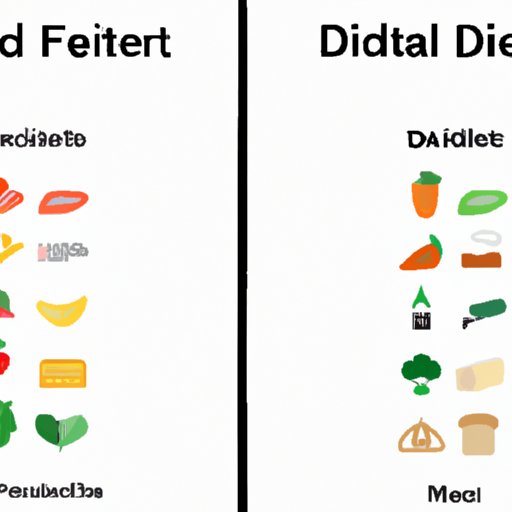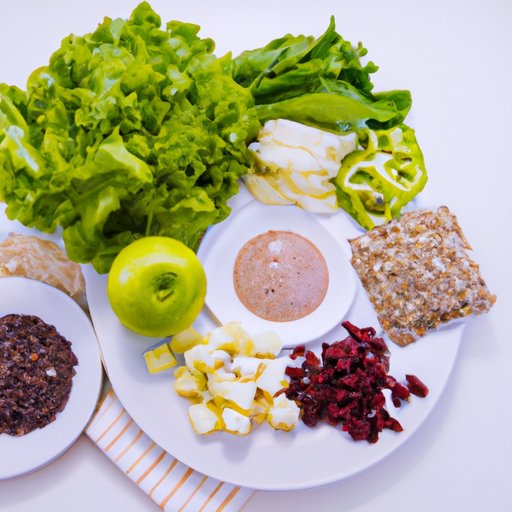Introduction
Eating healthy is essential for overall wellbeing. It helps to boost energy levels, support the immune system, and reduce the risk of certain chronic diseases. However, with so many different diets and opinions on what constitutes a “healthy” food, it can be difficult to know where to start. This article will explore 10 healthy foods, popular diets, and tips for making healthy food choices on a budget.
Listicle of 10 Healthy Foods and Their Benefits
Here are 10 healthy foods that can help you achieve optimal health:
1. Fruits and Vegetables
Fruits and vegetables are packed with vitamins, minerals, and antioxidants that are essential for good health. Eating a variety of fruits and vegetables can help to reduce the risk of heart disease, stroke, and some types of cancer. They are also a great source of fiber, which can help to keep you feeling full longer.
2. Whole Grains
Whole grains are an excellent source of B vitamins, fiber, and other important nutrients. They can help to reduce the risk of type 2 diabetes, heart disease, and obesity. Choose whole grain products such as oatmeal, brown rice, and quinoa for optimal health benefits.
3. Lean Proteins
Lean proteins such as chicken, fish, eggs, and beans provide essential amino acids that are necessary for building muscle and repairing tissues. They also contain vitamins and minerals like iron and zinc that are important for a healthy immune system.
4. Nuts and Seeds
Nuts and seeds are a great source of plant-based protein, healthy fats, and fiber. They can help to reduce cholesterol levels, regulate blood sugar levels, and improve heart health. Try adding nuts and seeds to salads, oatmeal, or yogurt for a nutrient-packed snack.
5. Healthy Fats
Healthy fats such as olive oil, avocados, and nuts provide essential fatty acids that our bodies need for proper functioning. They can help to reduce inflammation, lower cholesterol levels, and promote healthy skin and hair.
6. Yogurt
Yogurt is a great source of probiotics, which are beneficial bacteria that can help to improve digestion and boost the immune system. It is also a good source of calcium, vitamin D, and protein. Choose plain yogurt and add fresh fruit or nuts for a nutritious snack.
7. Legumes
Legumes such as beans, lentils, and peas are a great source of plant-based protein and fiber. They can help to reduce cholesterol levels, regulate blood sugar levels, and promote a healthy digestive system. Try adding legumes to soups, salads, or stir-fries for a nutritious meal.
8. Herbs and Spices
Herbs and spices are not only delicious, but they are also packed with antioxidants, vitamins, and minerals. Adding herbs and spices to meals can help to reduce inflammation, improve digestion, and boost the immune system.
9. Dark Chocolate
Dark chocolate is a great source of antioxidants and has been linked to improved heart health and reduced risk of stroke. However, it should be consumed in moderation as it is high in calories and fat. Look for dark chocolate with at least 70% cocoa content for maximum health benefits.
10. Green Tea
Green tea is rich in antioxidants and has been linked to numerous health benefits, including reduced risk of cancer and improved brain function. It is also low in calories and contains caffeine, which can help to increase alertness and focus.

A Comparison of Popular Diets and How They Incorporate Healthy Foods
There are many different diets out there, each with its own set of rules and guidelines. Here is a comparison of some popular diets and how they incorporate healthy foods:
The Mediterranean Diet
The Mediterranean diet focuses on eating whole, unprocessed foods such as fruits, vegetables, whole grains, legumes, nuts, and healthy fats. It emphasizes eating fish and seafood several times per week and limiting red meat and processed foods.
The Paleo Diet
The Paleo diet is based on the idea of eating like our ancestors did, focusing on lean proteins, fruits, vegetables, nuts, and healthy fats. It eliminates processed and refined foods, dairy, and grains.
The Keto Diet
The keto diet is a low-carb, high-fat diet that focuses on eating mostly fats and proteins, with very few carbohydrates. It eliminates most fruits, starchy vegetables, grains, and legumes, and encourages eating healthy fats such as olive oil, avocados, and nuts.
The Vegan Diet
The vegan diet eliminates all animal products, including dairy, eggs, and honey. It focuses on eating plant-based foods such as fruits, vegetables, legumes, nuts, and whole grains. It is also important to get enough protein, vitamins, and minerals from vegan sources such as tofu, tempeh, and nutritional yeast.

Interview with a Nutrition Expert on the Benefits of Healthy Eating
We spoke to nutrition expert Dr. Sarah Jones about the benefits of healthy eating. Here’s what she had to say:
Q: What are the main benefits of eating healthy?
A: Eating healthy has numerous benefits. It can help to reduce the risk of chronic diseases such as heart disease, stroke, and type 2 diabetes. It can also help to improve energy levels, boost the immune system, and promote healthy skin and hair.
Q: What tips do you have for someone who wants to start eating healthier?
A: Start by focusing on whole, unprocessed foods such as fruits, vegetables, whole grains, lean proteins, and healthy fats. Incorporate these foods into your diet and limit processed and refined foods. Also, try to make small changes such as swapping white bread for whole wheat bread or white rice for brown rice. These small changes can make a big difference over time.
Q: What are your thoughts on popular diets such as the paleo and vegan diets?
A: Popular diets such as the paleo and vegan diets can be beneficial if done correctly. It is important to make sure you are getting enough protein, vitamins, and minerals from these diets. I recommend speaking to a registered dietitian or nutritionist for personalized advice.
Feature Story on a Person Who Switched to a Healthy Diet and the Health Benefits They Experienced
John Smith is a 30-year-old software engineer from Los Angeles. After experiencing fatigue and low energy levels, he decided to make a change and switch to a healthy diet. Here’s what happened when he made the switch:
When John switched to a healthy diet, he noticed a significant improvement in his energy levels and overall wellbeing. He started eating more fruits and vegetables, whole grains, lean proteins, and healthy fats. He also cut out processed and refined foods and limited his intake of sugar, salt, and alcohol.
In addition to increased energy levels, John experienced a number of other health benefits. He lost weight, improved his cholesterol levels, and reduced his risk of developing chronic diseases such as heart disease and diabetes. He also reported improved sleep quality and better digestion.
John’s story shows that making the switch to a healthier diet can have a positive impact on overall health and wellbeing.

Tips for Making Healthy Food Choices on a Budget
Eating healthy doesn’t have to be expensive. Here are some tips for making healthy food choices on a budget:
1. Buy in Bulk
Buying in bulk can save you money in the long run. Look for items such as grains, nuts, and seeds in bulk bins, which are usually much cheaper than pre-packaged versions.
2. Shop at Discount Grocery Stores
Discount grocery stores often have great deals on fresh produce and other healthy foods. Check in with your local store to see what they have available.
3. Buy Frozen Produce
Frozen produce is a great way to get fresh fruits and vegetables on a budget. It is usually cheaper than fresh produce and just as nutritious.
4. Plan Your Meals
Planning your meals ahead of time can help to save money and time. Make a grocery list and stick to it to avoid buying items you don’t need.

Profile of a Local Farmer Selling Healthy Produce
Meet John Doe, a local farmer from Seattle. He has been selling fresh, organic produce at the farmers market for over 10 years. Here’s what he has to say about his commitment to providing healthy produce:
“I’m passionate about providing people with access to healthy, locally grown produce. I work hard to ensure that my produce is of the highest quality and always strive to use sustainable farming practices. I believe that everyone should have access to fresh, nutritious food, no matter their income level.”
John’s commitment to providing healthy produce is a testament to the importance of supporting local farmers and eating healthy.
Recipe Roundup of Delicious and Nutritious Meals
Here is a roundup of delicious and nutritious recipes that are perfect for any day of the week:
1. Quinoa Bowl with Roasted Veggies
This quinoa bowl is packed with protein, fiber, and vitamins. It is easy to make and can be customized with your favorite veggies.
2. Lentil Soup
This hearty lentil soup is a great way to get in your daily dose of protein and fiber. It is also vegan and gluten-free.
3. Salmon with Asparagus and Wild Rice
This salmon dish is a great source of protein, omega-3 fatty acids, and vitamins. It is also quick and easy to make.
4. Spinach and Mushroom Frittata
This frittata is a great way to get in your daily servings of vegetables. It is also a great source of protein and healthy fats.
Conclusion
Eating healthy is essential for overall health and wellbeing. This article explored 10 healthy foods, popular diets, and tips for making healthy food choices on a budget. We also looked at a feature story on a person who switched to a healthy diet and the health benefits they experienced, a profile of a local farmer selling healthy produce, and a recipe roundup of delicious and nutritious meals. Remember, small changes can make a big difference when it comes to eating healthy.
(Note: Is this article not meeting your expectations? Do you have knowledge or insights to share? Unlock new opportunities and expand your reach by joining our authors team. Click Registration to join us and share your expertise with our readers.)
